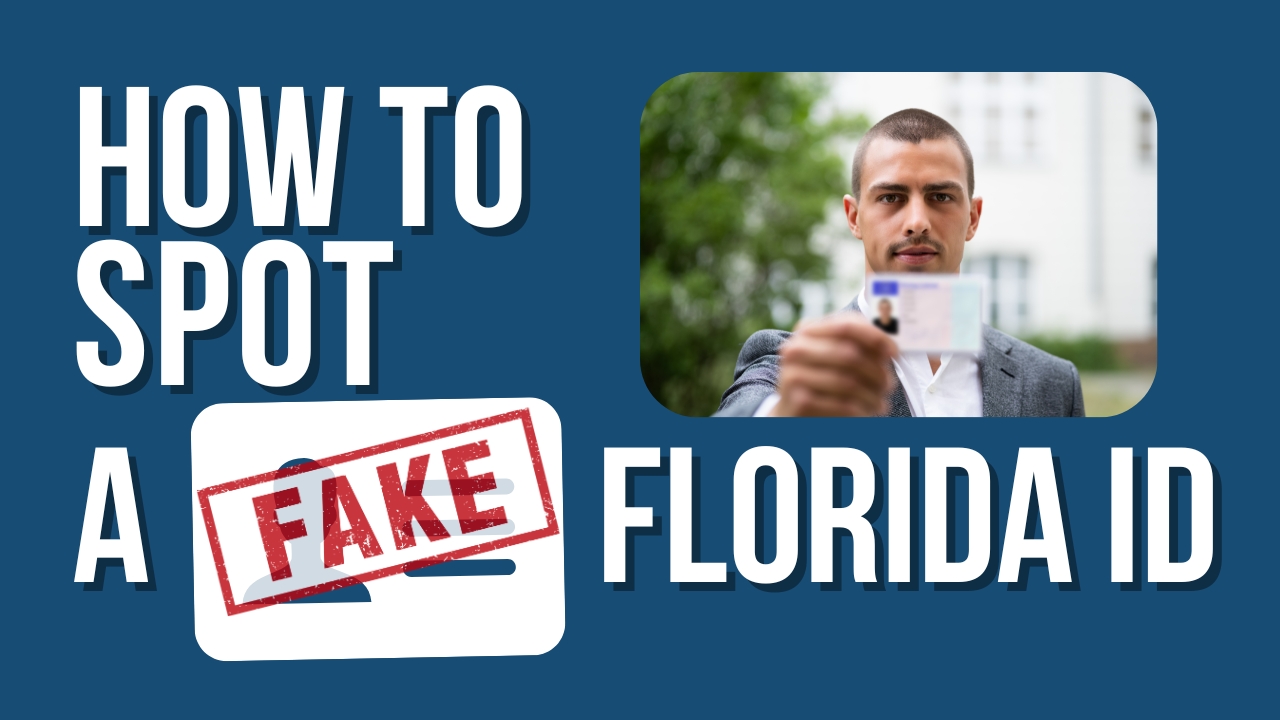
Revised 6/18/2024
How to Spot a Fake Florida ID
Not only must the signer be present for a notarization, but it is also your duty as the notary to ensure the signer provides adequate identification. While the average notary probably cannot detect expertly faked identification documents, certain hallmarks can raise suspicion. Being meticulous about checking identification can save you time, money, and hassle in the long run.
We recommend that you visit the Department of Highway Safety and Motor Vehicles ID Guide website to access the latest information and visuals.
Here are a few key features you can look for when examining a Florida Driver’s License:
The material and edge of the ID can be good indicators of authenticity.
- Real Florida IDs are sturdy, smooth, have uniformly rounded edges, and are one complete plastic surface
- Fake Florida IDsmay have edges that appear to be peeling or can be lifted. Their layers might give or buckle when slightly bent. Raised surfaces on the ID can indicate the layering of a photograph or other information on top of the original ID.
Florida security features should always be present.
- Real Florida IDs that are currently being issued have an optically variable ghost (OVG) near the middle of the ID and optically variable data (OVD) throughout. This OVG is essentially a faded copy of the main ID picture that is visible when the card is tiled and fluoresces when exposed to ultraviolet (UV) light. The gold look-through element behind the mini-portrait turns mostly clear in transmitted light, such as sunlight or a flashlight.
- Fake Florida IDs may lack OVG and OVD or may have poorly reproduced ones. While these are easily detectable, be aware that they can be faked. One way to tell if an ID is fake is by gently bending it into a "U" shape to check for air pockets in the layer between the OVG and OVD and the ID surface.
Real Florida IDs have features only seen under UV light.
- The optically variable ghost photograph and data include an UV response that fluoresces purple under UV lighting, regardless of the viewing angle.
- Look-through element with UV: The gold tint of the look-through element fluoresces yellow/green under UV light.
- When placed under a UV light, the card reveals in fluorescent yellow/green two diagonal ribbons of repeating “FLFLFL” and five outlines of the state of Florida together with the letters "FL."
Fake Florida IDs will not react to UV light.
Real Florida IDs have a tactile feature.
On the bottom right-hand corner, there is a laser embossed "FL" that you can feel when you run your fingers across the front of the ID only. If you can feel it on both sides, the ID is fake.
Additional details you can look for on the back of the ID.
- Real Florida IDs issued between 2004 and August 2019 have a magnetic strip that runs horizontally across the back of the ID as well as a 2D barcode. Any ID with an issue date after May 2019 without the new 2D barcode design is fraudulent. Visit the Florida Highway Safety and Motor Vehicles' website to familiarize yourself with both older and newer IDs.
- Fake Florida IDs may have discrepancies with the issue dates, magnetic strips only, or may have one-dimensional barcodes. These are all common signs that you are looking at a counterfeit Florida ID.
Regardless of the Florida-specific features, you should always pay attention to the details listed on the ID. Does the ID say the person before you is a 6’2” man, when you are clearly dealing with someone who is no taller than 5’7"? Is the license current? Does the birthday listed on the ID match the relative age of the person in front of you? If you are at all uncertain about the legitimacy of the Florida ID being presented to you, you can always ask for additional sources of identification.
What to do if you suspect fraud:
Do not notarize the document. In instances of suspected fraud or identity theft using a Florida driver license or ID card, please contact the Florida Department of Highway Safety and Motor Vehicles’ Fraud Unit.
Fraud Line: (850) 617-2405
Email: This email address is being protected from spambots. You need JavaScript enabled to view it.
Related Article(s)
Medallion Signature Guarantees Explained
How Do I Know That a Person Claiming to Be a Notary Really Is One?
May a Notary Correct Their Error or Omission on a Notarial Certificate?
How to Assess Signer Awareness or Coercion
What to Do When the Notary Certificate Is Missing?
Can I Notarize a Document That Is Already Signed?
Tips to Protect Your Notary Stamp and Journal
